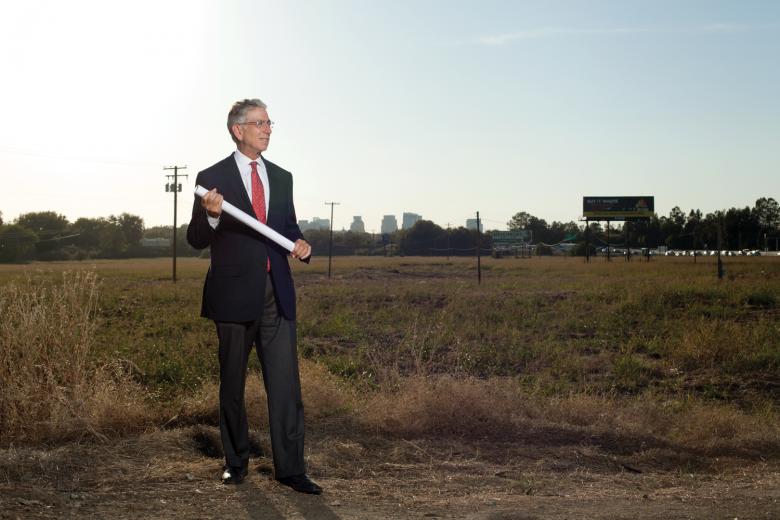Infill development is promoted as an antidote to suburban sprawl and environmental degradation and is championed by city planners, environmentalists and policy makers of all persuasions. But as local developers Paul Petrovich and Phil Angelides have long known, infill leads to fights over allegations of increased traffic or environmental hazards.
When this so-called smart growth actually moves forward, it “runs smack into political reality,” says Angelides, who has advocated for infill development throughout his career. The pushback from neighborhood groups can be costly and exhausting, but developers maintain that these types of projects are a vital part of meeting a community’s housing needs and cleaning up toxic land.
In Sacramento, Angelides is proposing McKinley Village, a 328-home development on 48 acres near McKinley Park and East Sacramento, two of Sacramento’s oldest neighborhoods. The site is adjacent to the Capital City Freeway and close to downtown Sacramento. It would be the region’s second largest infill project.
The proposed site for McKinley Village was once a peach orchard that became known as the Centrage property. In the past, developers have proposed bringing high-rise office buildings there, plus high-density apartments and a larger subdivision with a church. Angelides has a different vision: 328 homes in an urban village. This latest proposal is for fewer homes and a community center Angelides says will mirror the culture and architecture of its adjacent neighborhoods. With its proximity to downtown and planned access to commercial areas along Alhambra Boulevard, the property fits the concept of smart growth.
Despite the environmental appeal and efficient use of mass transit, infill projects face a unique challenge. Unlike new developments planned over bare dirt, these have to mesh with an existing neighborhood, much the way a room addition has to complement a house already built.
Angelides believes the first obstacle to any neighborhood development is overcoming the natural resistance of people who live nearby. “People are afraid of change, especially when they don’t know the facts,” he says.
So far, early opinion about McKinley Village is mixed. Some neighborhood associations have applauded Angelides’ willingness to discuss his plans. Others are skeptical. “It seems to us that the plan they have shown us is a done deal and there is little room for changes,” says Tina Cerruti, who recently formed Neighbors United for Smart Growth, a group that filed 400 comments with the city in response to a preliminary step taken by Angelides’ to develop an environmental impact report.
Cerruti says she is also concerned about the lack of access to the site and the added traffic that would be directed to just a couple of residential streets. “It’s really not part of East Sacramento,” she says. “It is so isolated, we wouldn’t know the development is there — except for the traffic.”
That said, Cerruti contends her group is “looking for ways to make this work.”
A preliminary environmental report is expected to be released in the fall. It will offer up the first factual look at how the proposed development will affect the surrounding neighborhoods. In order to rally public support around his project, Angelides claims to have held about 60 stakeholder meetings.
“Education is key,” he says. “I can’t just ask them to trust me because I’m a nice guy.”
Paul Petrovich is much further along with the Curtis Park Village, another infill project on the other side of town that is ready to break ground. A former baseball player at UC Davis, Petrovich takes a tougher, no-crying-in-baseball approach to dealing with opposition.
“People are afraid of change, especially when they don’t know the facts.”
Phil Angelides
“I have a hard-nosed competitive edge, and I don’t lose,” he says. “I never hire a spokesman or a lawyer to speak for me. I do it myself because everything I say I’m going to do, I’m going to do. There is never an excuse that my lawyer misspoke about a commitment.”
After a decade of planning, evaluation and spirited public debate, the $211 million mixed-use project is rising out of a toxic pit of an old railroad yard adjacent to Sacramento City College.
The 72-acre development includes single-family cottages, multi-family housing and retail space. It eliminates an environmental eyesore left behind when Western Pacific railroad abandoned the site. It also knits together two of Sacramento’s most established neighborhoods, Curtis Park and Land Park.
The first public meetings about Curtis Park Village were far from mild-mannered. According to Petrovich, opposition to the project by the Sierra Curtis Neighborhood Association was the result of a handful of attorneys who lived in the neighborhood bringing unfounded allegations about increased traffic and environmental hazards. “Their No. 1 weapon of choice was misinformation,” Petrovich says.
The Sierra Curtis Neighborhood Association publishes a newsletter. “They had three to five articles in every issue expressing their viewpoint and never once called to ask for my opinion,” he says. For example, the group alleged that thousands of cars would flood the adjoining neighborhoods, a concern that was disputed in a formal traffic study.
Eric Johnson, president of the Sierra Curtis Neighborhood Association, credits those critics for forcing changes that ultimately made the development more compatible with the neighborhoods around it. “There is no doubt that Petrovich took on a big challenge when he bought the property, and you couldn’t have started with anything worse than dozens of acres of toxic dirt,” he says. “There will always be give and take, and projects like this have to work for the developer, the neighborhood and the city. But it’s easy for a neighborhood association to get steamrolled if the developer has enough money and drive.”
Now that construction is beginning, the association is “cautiously optimistic” that the development will reflect the vision that the association fought for, Johnson says. “The market is finally realizing what we were proposing,” he says, referring to more single-family homes and less commercial space and what he calls the project’s “walkability and livability.”
The history of the site gave critics a lot of ammunition to stir up distrust. The environmental hazards on the property, the legacy of running a railroad, were generations in the making. The environmental impact report, which evaluated the site for air quality, traffic, hazardous waste cleanup and other potential ills, ran 2,100 pages, almost twice the size of Tolstoy’s War and Peace.
The environmental cleanup was technically difficult and three times more expensive than first estimated. The amount of dirt taken offsite to get rid of toxic metals, 1.5 million cubic yards, could fill the adjacent Hughes Stadium to the brim three times over. A mini-ocean of nearly a half billion gallons of water was pumped through the site to flush 142 pounds of toxic metals from the underground aquifer.
Ultimately, the project was endorsed by the Sierra Club, the Environmental Council of Sacramento and the Architects Institute of America. Curtis Park Village was approved unanimously by the Sacramento County Planning Commission and City Council, with 215 conditions attached to the plans.
Those conditions include a multi-million dollar pedestrian bridge to link Curtis Park Village to Sacramento City College, traffic light synchronization and an upgraded off ramp on nearby Highway 99. They illustrate another challenge of infill developments. In many cases, because they fill spaces that were neglected or blighted, infill projects are used as opportunities to fix problems that were generations in the making.
The give and take with local neighborhood associations, as well as changes in the market over the 10 years it took to get the development approved, resulted in changes to the final Curtis Park Village design. Some multi-family housing was reoriented to move it closer to mass transit. Commercial space was reduced while residential space was increased. A proposed hotel was dropped from the project.
“In all, I think we made about 42 changes to the project because of suggestions from the neighborhood associations,” Petrovich says.
Most recently, in a sign of an improved relationship with former critics, the Sierra Curtis Park Association recently approved adding 75 single-family homes and reducing multi-family housing within the project.
But getting to the project’s final form was more arduous than the toxic cleanup and required 230 community meetings over the decade. As Petrovich fought for his project during that time, the developer displayed the same pugnacious attitude he once applied on the ball field.
“Some people don’t believe in private property rights,” Petrovich contends. “I was cleaning up a cancer pit with my own money. They thought the project should have been treated like it was public property.
“I went to every one of those meetings, and my goal was to refute every allegation. After a while, I gained with the silent majority, and people were angered that they had been lied to by the more vocal group.”
Despite the pushback, both Angelides and Petrovich agree that addressing concerns of neighborhood associations is an important aspect of infill development. In many cases, reviews and suggestions by neighborhood groups can improve projects. “Most people want to understand what you’re trying to do,” Angelides says. “You’re not going to make everyone happy. But if you keep your door open and listen and work to solve real problems, you will prevail.”
Petrovich believes that, despite the extraordinary challenges and expense of infill projects compared to suburban development, they make sense for many reasons. “I’ve been an infill developer most of my career,” Petrovich says. “I’ve torn down crack houses and old car lots and assembled the properties into constructive uses.” In addition to reducing the environmental burden on the community, Curtis Park Village will generate $2.7 million in property taxes and $900 million in sales tax a year, unexpected new revenue for the city.
While infill projects provide many advantages, they can meet only a small fraction of the region’s housing needs. “The area will need 24,000 new homes by 2021,” notes Angelides, most of which will be built in sprawling subdivisions.
TELL US WHAT YOU THINK: DO NEIGHBORHOOD ASSOCIATIONS HELP OR HURT REVIEW OF INFILL PROJECTS?
Recommended For You

Putting the Fab in Pre-Fab
Modular construction cuts construction and energy costs
The final stages of construction at a trend-setting apartment project in San Francisco’s SoMa neighborhood, known by its address at 38 Harriett St., largely resembled a life-sized game of Tetris.

If You Rebuild It
Serial entrepreneur Scott Syphax rises from the rubble
Scott Syphax is an unlikely person to garner a nickname like Dr. Doom. After all, the president and CEO of Sacramento-based Nehemiah Corp. of America is far too thoughtful and deliberate to be saddled with a sobriquet more in line with a snickering cartoon villain.




